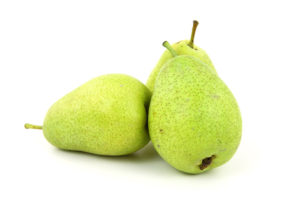Pear juice is healthy and nutritious, although it doesn't contain as much fiber as raw pears.
One of the benefits of drinking pear juice over eating pears is that you generally take in more nutrients when drinking the juice.
This is because one glass of pear juice of, say, 25cl is equivalent to 3-4 whole pears; and everyone finds it easier to drink one glass of juice than to eat 3 or 4 pears.

Remember the peel
It's old news that the peel of fruits and vegetables contains more nutrients than the fruit or vegetable itself. This is also true for pears, where the peel contains 3-4 times as many nutrients as the flesh. Pears are also known to be high in fiber; half of the pear's fiber is in the peel.
Of course, when juicing pears, you need to keep the peel on the pears to get all the nutrients – and drinking pear juice rather than eating the pears whole hardly “cheats” you of any nutrients. The only value that is reduced is the fiber content, which is because the fiber is largely the solid parts of the pears – like the peel – and therefore only to a limited extent is included in pear juice and pear juice.
Cloudy or clear pear juice?
By now, most people have heard that cloudy juice – where not all the pulp has been filtered out – is healthier than clear juice.
It is now known that filtered pear juice contains up to 40% less nutrients than unfiltered pear juice. Therefore, it is recommended that you only buy cloudy pear juice or even better, make your own pear juice.
The effect of pear juice on diseases
Although some websites may exaggerate the beneficial properties of pears a bit, there are several good reasons why researchers today are very interested in pears and their ingredients. In the following, we have summarized some of the research on the effects of pears on some of today's most common diseases.
Diabetes
There has been a lot of research into the effects of different fruits on blood sugar levels and diabetes (type 2). Pears are one of the fruits that have received particular attention because they have been shown to be the most effective of all fruits in reducing the risk of diabetes. This is thought to be due to the pears' special content of flavonoids and, to some extent, anthocyanins, which are found in some of the red-peeled pear varieties.
This is one of the reasons why diabetics are now recommended to eat pears and other fruits. Does this mean that pear juice can cure diabetes? No, but researchers are still investigating the compounds in pears in the hope of using them to treat the disease.
Heart disease
Because pear fiber can bind bile acid in the intestines and thereby reduce cholesterol synthesis, some researchers believe that pear fiber could potentially be used to treat heart disease.
A 2006 study compared the ability of pear fiber (and other fruit fibers) to bind bile acid with the drug colestyramine, which was developed for this very purpose. The study showed that pear fiber has 5% of the drug's ability to bind bile acid. Bananas and pineapples have 9% and 6% respectively, surpassing the ability of pears.
As with diabetes (above), this does not mean that pear juice can be used to directly treat heart disease, but that there may be medicinal potential in their fiber.
Cancer
Pear fiber not only binds the aforementioned bile acids, but also the so-called secondary bile acids, which in excessive amounts can increase the risk of bowel cancer and other intestinal problems. In other words, it is believed that pear fiber may reduce the risk of developing bowel cancer by binding the secondary bile acids.
Some research also suggests that pears and pear juice can be used to lower the risk of stomach cancer. However, the focus here is not on the fiber, but on the plant nutrient cinnamic acid. The same research also highlighted mango as a good source of cinnamic acid, which may also lower the risk of stomach cancer.
In addition, a large study with 490,802 participants showed that pears were one of the foods that could protect against esophageal cancer. However, it should be mentioned that apples, peaches, nectarines, plums, strawberries and citrus fruits were also found to be protective.
Although pears cannot be said to prevent or counteract cancer, much of the research to date indicates that pears and pear juice, for example, can be used to reduce the risk of certain cancers.
5 recipes for pear juice
These recipes all require you to have a juicer and the process is simple; just run the ingredients through the juicer:
Pure pear juice
- 4 pears
Be aware that there are different varieties that give different flavors and that the ripeness of the pears also changes the taste of the finished juice.
Apple and pear juice
- 2 firm pears
- 2 green apples
Carrot and pear juice
- 2 pears
- 2 medium carrots
- 1 green apple
Spinach and pear juice
- 2 firm pears
- 2 apples
- 2 cups of fresh spinach leaves
- a few mint leaves
Broccoli and pear juice
- 1.5 cups broccoli (stems as well as heads can be used)
- 2 pears
- 1 green apple
